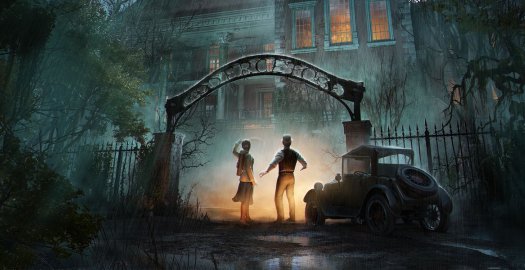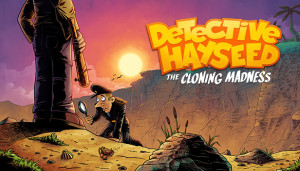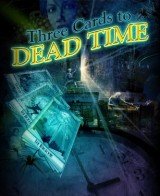Review for Alone in the Dark

Game information
Forget remakes, reboots, legacyquels, or all those sorts of things. For this new Alone in the Dark, produced by the Swedish studio Pieces Interactive, we must define a new term: the love letter. Rather than giving a polish to the ancestor of Survival Horror, replacing a handful of textures or bringing dusty gameplay up to date, Mikael Hedberg and his team have completely rethought the way to bring an old myth up to date, between veneration and new proposal: a dangerous balance aimed at rekindling the worn hearts of fans of yesteryear while delivering an adventure capable of inviting new generations to wander the cursed corridors of Derceto.
Most Survival Horror fans know the story. Resident Evil, in 1996, the Capcom game that initiated a popular genre that endorsed a model with porous boundaries between action games, adventure games, narrative games, and above all, big haunted houses, is itself very inspired mainly by another title: Alone in the Dark. The latter has become the matrix of Survival Horror, which will define the cogs of game design, haunting more than thirty years of video game horror stories. A character stuck in a closed environment who will have to use what comes to hand to survive, escape creatures, and solve puzzles. All, of course, by making the most of the staging afforded by this famous third-person view with a fixed camera.
Thanks to these new possibilities of staging, in 1992, Frédérick Raynal and Infogrames' game not only definitively influenced a genre but also an entire industry. From Final Fantasy VII to Grim Fandango, from Yoshinori Kitase to Tim Schafer, Alone in the Dark affected the way this fragile, nascent 3D was used to give an additional dimension to video games. And despite this incredible aura, Frédérick Raynal's game ultimately only had a very moderate lineage with a number of sequels which did not always convince; and above all it was a game that remained in the shadow of the Japanese giant, Resident Evil. Despite several attempts, in 2001 at Darkworks with Alone in the Dark: The New Nightmare, then in 2008 at Eden Studios, the license gradually lost its identity, and the luster of its prestigious authorship became an object relegated to museums or the anecdotes of old players.
By chance acquisitions, Infogrames became Atari, and the license passed from hand-to-hand until it fell into the hands of THQ Nordic in 2018. The discreet Swedish studio Pieces Interactive (Magicka 2, Titan Quest: Atlantis) joined the services of Mikael Hedberg, the great pope of video game horror responsible for Amnesia: The Dark Descent (2010) and Soma (2015), two acclaimed and influential works in the microcosm of horror adventure games. Pieces Interactive's initial project was to produce an almost "stricto sensu" remake of the ancient glory of Infogrames. It was a remake that was so respectful that it was considered to keep fixed cameras and puzzles similar to the first Alone in the Dark. However, following a presentation of the project in early 2019 to the management of THQ, Pieces Interactive benefited from a larger budget, changing the paradigm and reimagining what Alone in the Dark could represent in this new decade.
In Frédérick Raynal's seminal game, the plot begins with Jeremy Hartwood's suicide in the attic of a mansion called Derceto. At the player's discretion, Emily Hartwood, niece of the unfortunate man, or Edward Carnby, private detective, will enter the house to investigate and quickly discover the presence of mysterious creatures, an unholy cult, and an evil sorcerer named Ezechiel Pregzt. Thirty-two years later, Mikael Hedberg and his team decided to modify the destiny of Jeremy Hartwood very slightly. What if the latter, standing on his chair with the rope around his neck at the last moment, resigns himself and decides to give himself one last chance? The player will, once again, have the possibility of embodying Emily or Edward (Emily's campaign is slightly less impressive than Edward's) and carry out a parallel investigation in this Derceto, which has become an asylum and rest home. An inquiry into the borders of madness, dreams, voodoo, and indescribable beliefs. An investigation peppered with nightmares, machinations, and strange characters. Because if the first Alone in the Dark turned out to be a solitary adventure as its name might suggest, the 2024 version is paradoxically much more verbose and gives pride of place to encounters. It remains to be seen which ones are the fruit of your imagination and especially which ones will not lead you towards certain death, because Alone in the Dark is a nightmarish journey where reality and fiction mingle in a dreamlike dampness that only the environment of swamps of Louisiana could embody in such a visceral way.
To allow the unfortunate player to carry out his investigation and survive Derceto, Pieces Interactive chose to abandon the systemic aspect of Frédérick Raynal's game. This gameplay sometimes offers several possible paths to survive a danger, emphasizing flight and evasion more than combat (and the latter tends to be unconvincing). Alone in the Dark (2024) uses the modern comfort of the latest versions of Resident Evil (notably the remakes of 2 and 3) as a basis for its gameplay. Players move Edward or Emily quickly and flexibly, with no more "tank controls". The weapons are drawn and activated with the edges, and players run and wander with a shoulder-mounted camera, which is so classic today. Alone in the Dark has chosen to base its gameplay on particularly well-established routines without the audacity to change the formula, even timidly. For its part, the overall design will curiously try to dust off the first Resident Evil.
The discovery of Derceto is quite similar to that of Resident Evil's Spencer mansion, but, above all, the wanderings and the imperative need to scrutinize every detail of the environment recall, not without charm, the simplicity and effectiveness of a recipe which has been lost a little with age. Alone in the Dark is a game that restores decorum's importance, and the developers have understood this well. The care given to every tiny detail of each living space borders on unreason. Each painting, each newspaper left carelessly on a table, each piece of furniture, or each reflection in a window contains a story and could reveal dark secrets. With, as one might suspect, limited budgetary means compared to Capcom's behemoths, Pieces Interactive preferred to bring morbid care to every detail, refining its mansion so that it recovered that dazzling luster that we had known it for thirty years earlier. If the game design mechanics are also a little dusty: a key = a door or a few objects to accumulate to unlock a passage; the quality of the puzzles and, above all, the remarkable balance found between the frustration of an overly complicated situation and the relatively modest level of support given to the player, is pretty ideal. Failing to offer incredible and explosive situations every two minutes, as in Resident Evil, Pieces Interactive has made the humble choice to treat each part of its numerous puzzles with a careful design, finely studied and perfectly integrated into its narrative. A narration which, moreover, forms a straightforward bridge with the first game in its primary vector of information: reading. Alone in the Dark (2024) is an exceptionally written game. Many plots of its history, clues, and elements of understanding of the interwoven intrigues are hidden in the texts scattered throughout the manor. Nothing new? Maybe. But the quality of writing and overall coherence is remarkable. And if the profusion of text refers very clearly to the first game, it also pays homage to the essential element of this new 2024 version: the Lovecraftian myth.
Let's put our cards on the table. The new Alone in the Dark is the best Lovecraftian-inspired game ever made. Let us point out that it draws as much from the founding stories of the master of Providence as from the immense lore nourished by his successors: Bloch, Derleth, and others. But it also draws from the more standardized universe created by Chaosium for its role-playing game, Call of Cthulhu. If Alone in the Dark is not an official Call of Cthulhu product, it bears all the stigmata to the depths of its (black) soul. Suppose you're unfamiliar with Lovecraft's writings and the untold pantheon he created, from Cthulhu to Shub-Niggurath and Yog-Sothoth to Kadath. In that case, this is a part of the plot that will probably be unfamiliar to you, as it is obscure, even once the game is finished. Still, it is, above all, its interpretation and brilliant and complicated use of Lovecraftian lore that will escape you. The already very referential Amnesia: The Dark Descent (Frictional Games, 2010) should have alerted us, and if Alone in the Dark by Infogrames was already a game with an assumed Lovecraftian essence, that of 2024 pushes all the knobs all the way. The game draws cheerfully and for our greatest happiness from the legendary campaigns of Masks of Nyarlathotep and other significant expansions of the role-playing game of Chaosium. It refers directly to specific short stories from the great elders, but above all, demonstrates erudition on the subject, which makes Alone in the Dark a game that quickly goes beyond the status of "vaguely inspired" by "primary element of the lore". Understand that in this respect, Pieces Interactive's game is not limited to making vague nods to the fans but integrates and uses this universe in an admirable way to give it consistency and unprecedented coherence.
The adventure then takes on a cosmic momentum that I did not necessarily expect. It effectively uses these influences to offer the player a welcome variety that I will not list but that pushes back the walls of Derceto. A variety is illustrated by often astonishing decorations, perfectly executed taking into account the proven technology used to recreate the historical context of the Great Depression, this dark period in history which experienced a severe global economic downturn, affecting many countries across the world. The artists of Pieces Interactive summoned both flamboyant art deco and figures disembodied by Alberto Giacometti in a decayed ensemble already worn by time and abandonment, like the witness of a past glory, all enveloped in the jazzy and captivating layers of the sound of Árni Bergur Zoëga and Jason Kohnen. Let us also note the remarkable work of the audio designers who immerse the player so well in a maelstrom of disturbing sounds that progression through the gloomy corridors of Derceto is like a waking nightmare. Moreover, the game sometimes has the air of a Lovecraftian best-of in the choice of its environments, from the Victorian mansion to the dark and sticky alleys of New Orleans, including swamps and other exotic places that I will not reveal here. Not only does the game look good, but it suffers from almost no technical slowdown (tested on PS5). Here, too, the choice of humility and modesty, of the adequacy between the means available to Pieces Interactive and their ambitions, offer a result without a false note, even if more modest than certain enormous AAA productions of the genre like Alan Wake 2 or Resident Evil 4.
What could, finally, definitely tie the rope is the metaphorical dimension of Alone in the Dark and its reflection on the inevitability of the original story. It's hard to be too specific for fear of spoilers, but the game is a fascinating depiction of the mental psyche of a modern creator confronted with a story already pre-established and experienced by many players. Taking on the air of mental hide and seek compared to the original elements, Alone in the Dark takes the form of a metaphorical struggle of an allegorical character, Jeremy Hartwood, to flee the original elements of his dark destiny. What will be the outcome? This is ultimately the most exciting narrative interest of the game. However, that meta reading of Alone in the Dark is not essential to a good understanding of the scenario, but it reveals a second level of interpretation that depends enormously on your knowledge of the original episodes, the creative context, and your level of nerdiness.
Alone in the Dark is, moreover, a very compact game. Without downtime, inviting the player to evolve cautiously with soft steps at the pace set by a dynamic staging, solving an enigma while remaining in a room and searching every corner, almost becomes an action scene. Suppose the main adventure could end in eight or nine hours (including a somewhat terse finale). In that case, it is more than appropriate to replay the campaign with the other character, as the two adventures complement each other and give another look at the events that take place in Derceto. Let us add that the inevitable search for hidden objects offers rewards beyond the simple satisfaction of completion and that a relatively exciting audio commentary is offered to the most curious. Alone in the Dark is an adventure that we no longer necessarily expected, halfway between a big production and a traditional adventure game, lost in an in-between that we had somewhat forsaken for years. It is an invaluable gift for those who instantly abandon themselves to Lovecraftian stories and a humble and careful experience for lovers of old-fashioned survival horror. A love letter to Alone in the Dark, indeed, but above all, a love letter to a mood and an atmosphere that the zombies of Resident Evil and Dead Space had almost made us forget.
If the idea of diving headfirst into a breathtaking adventure where voodoo, mysterious cults, haunted mansions, ritual sacrifices, and Great Old Ones (while maintaining a discreet sense of humor and second-degree separation) tempts you, it is likely that this love letter to Alone in the Dark will merit a solid and entirely unexpected recommendation. Pieces Interactive's survival horror revives the old and hackneyed formulas of the genre to offer an adventure that entirely rests on the quality of its atmosphere and narration—looking forward to the sequel!











__medium.jpeg)















